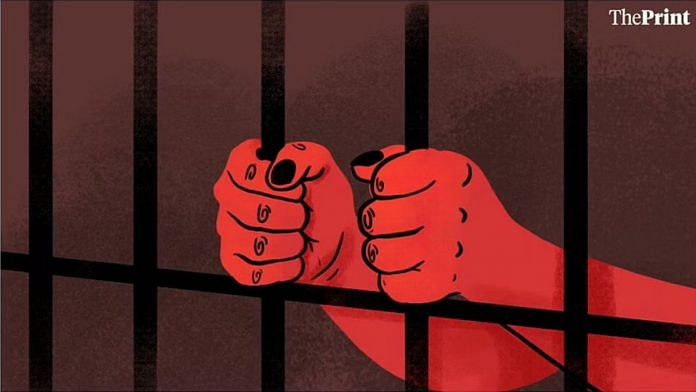India’s overcrowded prisons confined more than half a million inmates at the end of 2021, with a majority of them being those under trial for crimes they had allegedly committed. Among the 5,54,034 inmates across India’s prisons, 77.1 percent were under-trials and 22.2 percent were those who had been convicted by a court of law, data from the National Crime Records Bureau (NCRB) shows.
India currently has the sixth highest share of pre-trial detainees in the world, according to data collated by the World Prison Brief. The five countries that fare worse than India are Liechtenstein, San Marino, Haiti, Gabon and Bangladesh.
The slow-turn of the wheels of justice
This large share of the under-trial prison population is not a recent phenomenon, but has persisted for decades now. A Law Commission report from 1979 noted that the share of those in pre-trial detention was 57.6 percent as of January 01, 1975, and the Commission lamented that “jails should primarily be meant for lodging convicts and not for houSing persons under trial.”
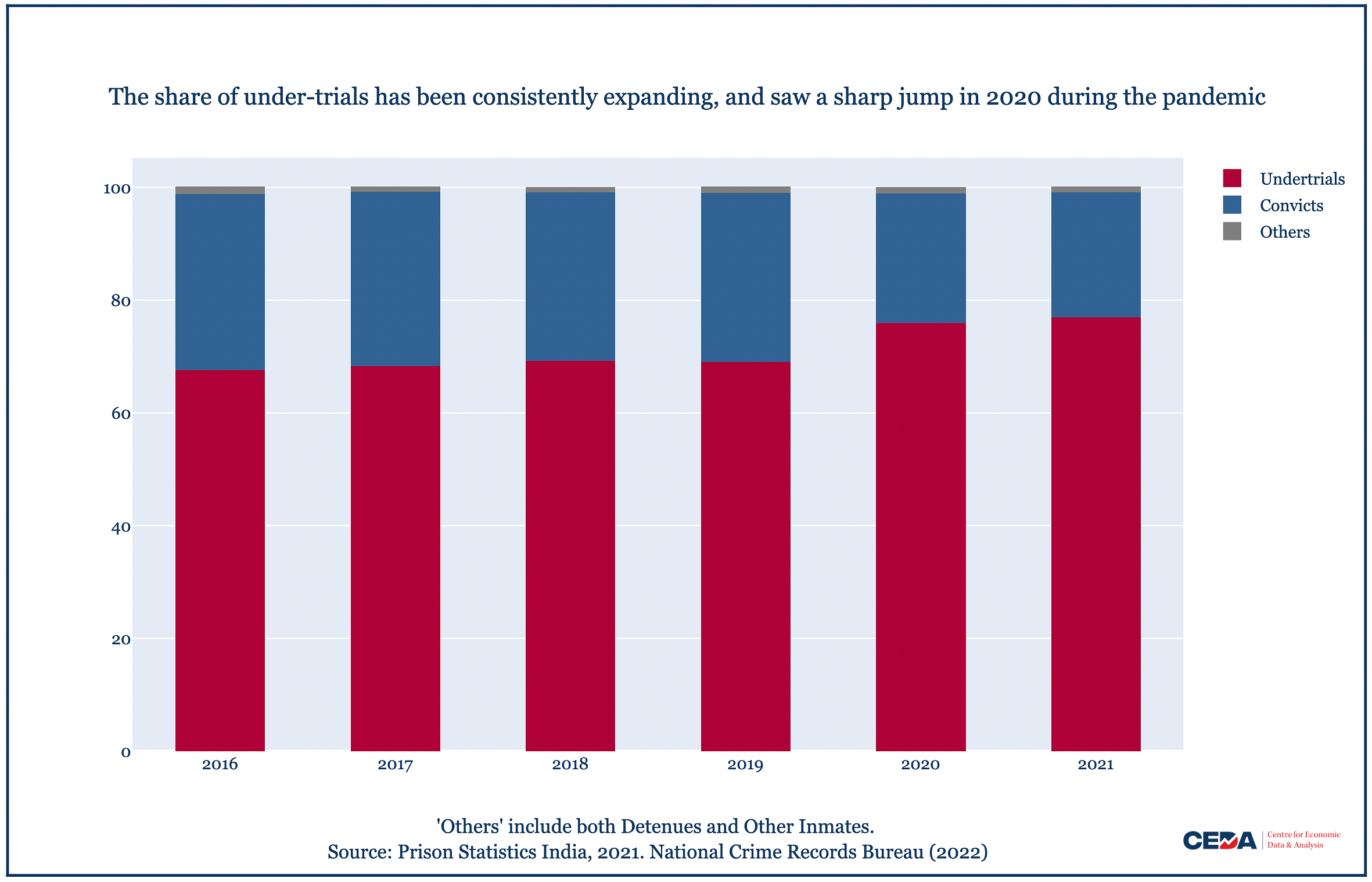
While India’s justice processes have been infamous for the slow dispensation of cases for a long time now, the Covid-19 pandemic further decelerated judicial processes.
The lockdowns imposed to check the spread of the disease and social distancing requirements severely restricted the functioning of Indian courts. After the nationwide lockdown was imposed on March 25, 2020, Indian courts worked on reduced capacity for months, bridling the trial and justice processes for thousands of Indians. Even as the number of prisoners grew, 2020 saw a fall in the number and share of convicts. The number of those under-trials continued to grow. This was despite efforts of the Supreme Court right from the early stages of the pandemic to decongest prisons to avoid the spread of the disease among inmates.
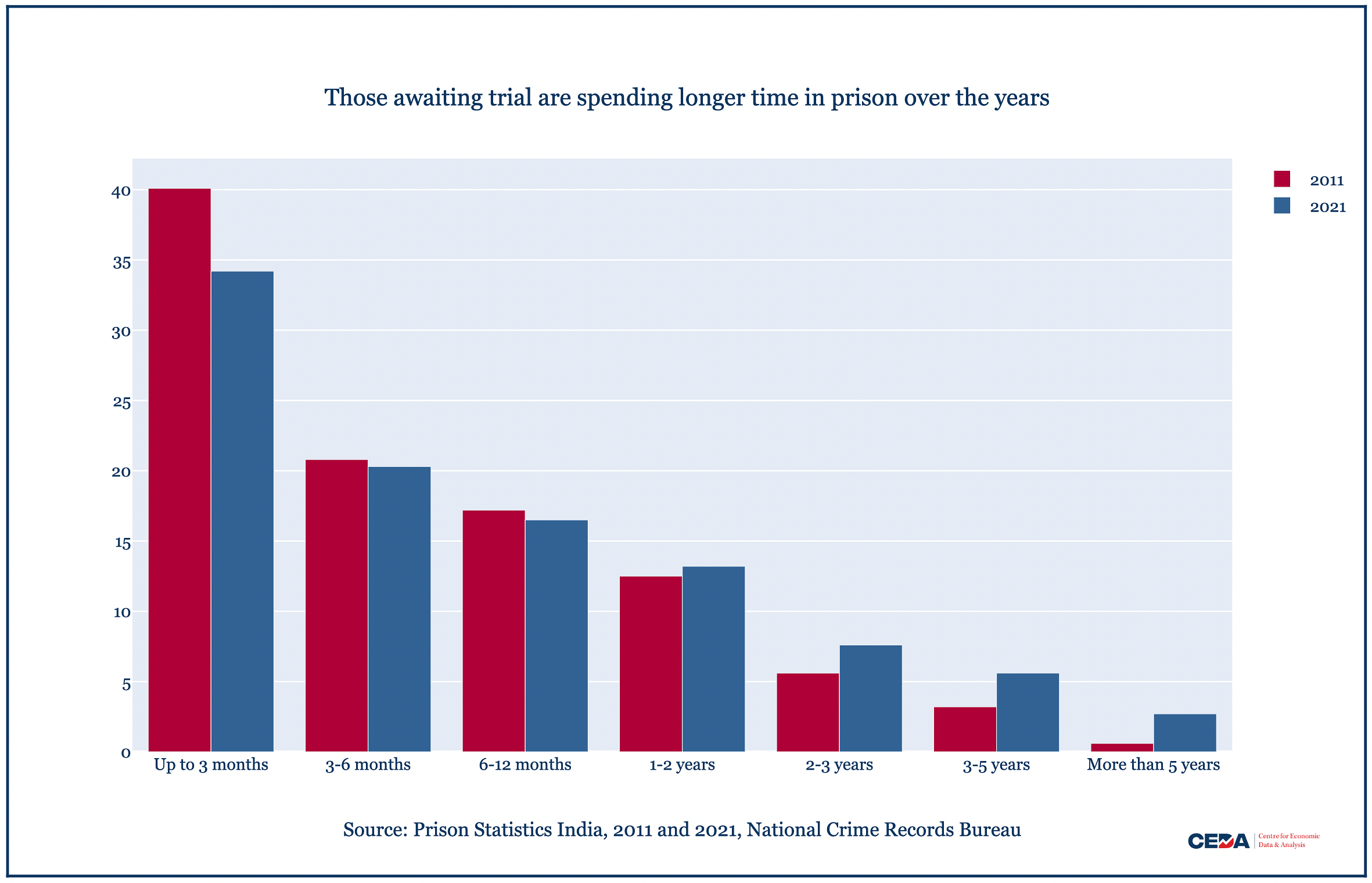
With the wheels of India’s trial courts turning slowly, those awaiting trial are spending longer time in prison over the years. In 2011, 40.1 percent of those under-trial had been in prison for less than three months, while almost 22 percent had been imprisoned for a year or more. By 2021, 29.1 percent of under-trials had been in prison for more than a year.
Also read: ‘In the process of evolving’ — How a Madras HC judge is making Tamil Nadu LGBTQIA+ friendly
Prolonged undertrial detention leads to several concerns
Such lengthy detention of unsentenced prisoners has its origins in two common phenomena, notes Human Rights Watch: “the denial of pretrial release to criminal defendants, and the excessive duration of criminal proceedings.” And both of these violate international human rights norms, and “combined together they constitute a grievous affront to justice”, the international organisation observes. Additionally, the inability of several inmates to pay for their bail bonds means they end up languishing in prisons even when they could be out.
Prolonged undertrial detention leads to several concerns, according to a report by Amnesty International (2017). Such detention can violate the rights to liberty and fair trial, and also adversely impact the lives and livelihood of those incarcerated. Prolonged undertrial detention also increased the risk of torture or other ill-treatment.
These cautious observations need to be read against the context that undertrials in India tend to overwhelmingly come from marginalised backgrounds, with Dalits, Adivasis and religious minorities – especially Muslims and Sikhs – overrepresented among prison inmates.
Also read:
Religious minorities are overrepresented among prison inmates, but there have been some shifts
A dominant share of those in prisons at the end of 2021 were men (95.8 percent) and those with little or no education. A quarter of all those in prison (25.2 percent) at the end of 2021 were illiterate, and another 40.2 percent had not studied beyond class tenth.
And those who come from minority religious and caste communities are overrepresented among prison populations.
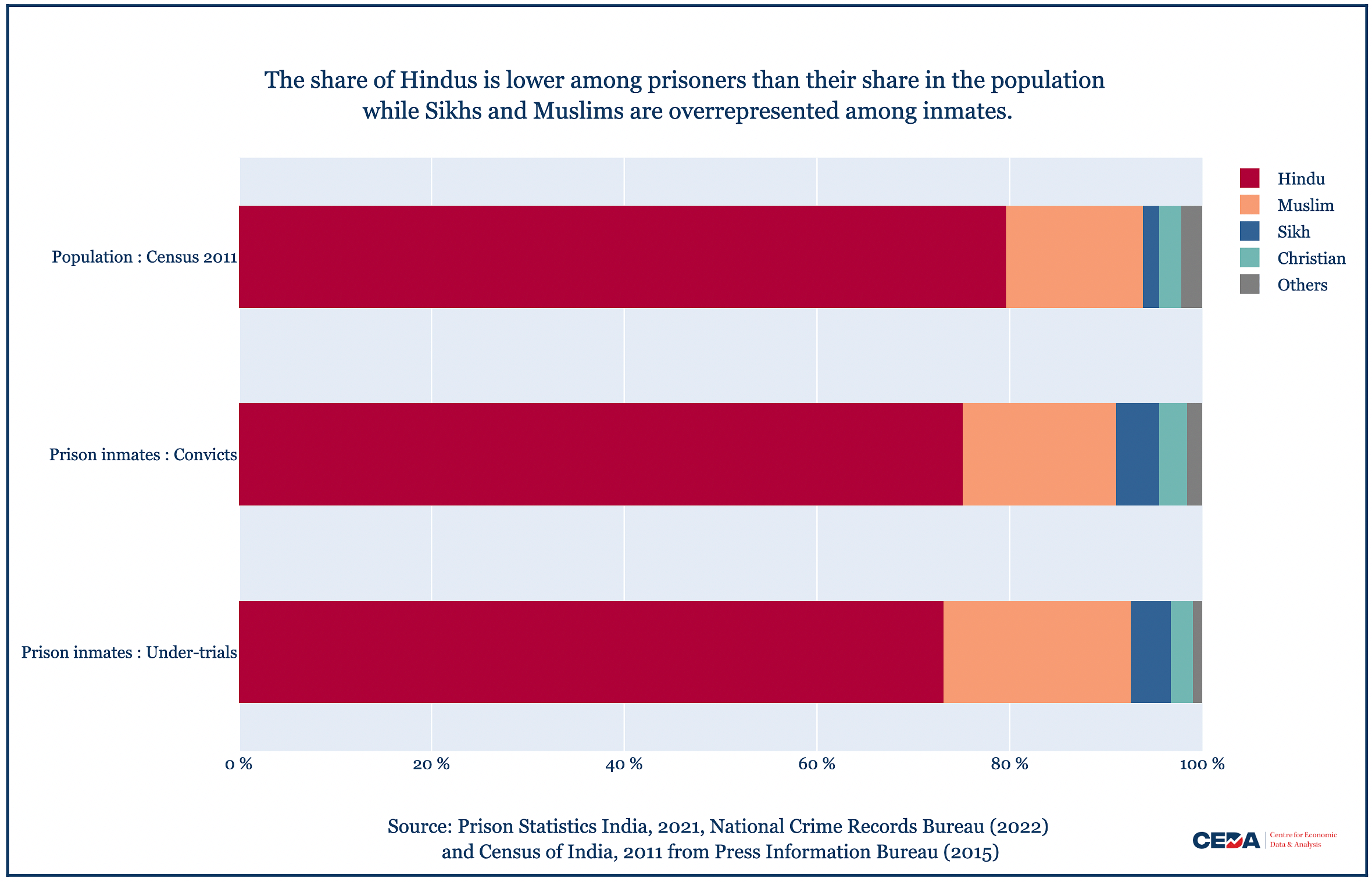
While the share of Hindus is lower among convicts and under-trials than their share in the population, Sikhs and Muslims are overrepresented among both kinds of prisoners.
And there is a gap in the religious composition of those under-trial vis-a-vis those who have been convicted. Muslims are the only religious group whose share is larger among the under-trials than among the convicts, whereas for other groups, the trend is the opposite.
Around the world, those from marginalised communities are often more likely to be suspected of criminal behaviour, more likely to be detained in prison while awaiting a trial, and if convicted, likely to be punished more severely, says Fair Trials, a global criminal watchdog.
In India too, studies have pointed out a bias within the criminal justice system. A study from Maharashtra found that Muslims were overrepresented in jails in the state, and that there was a link between how the criminal justice system operated with the discrimination faced by those from the community (Raghavan and Nair, 2013).
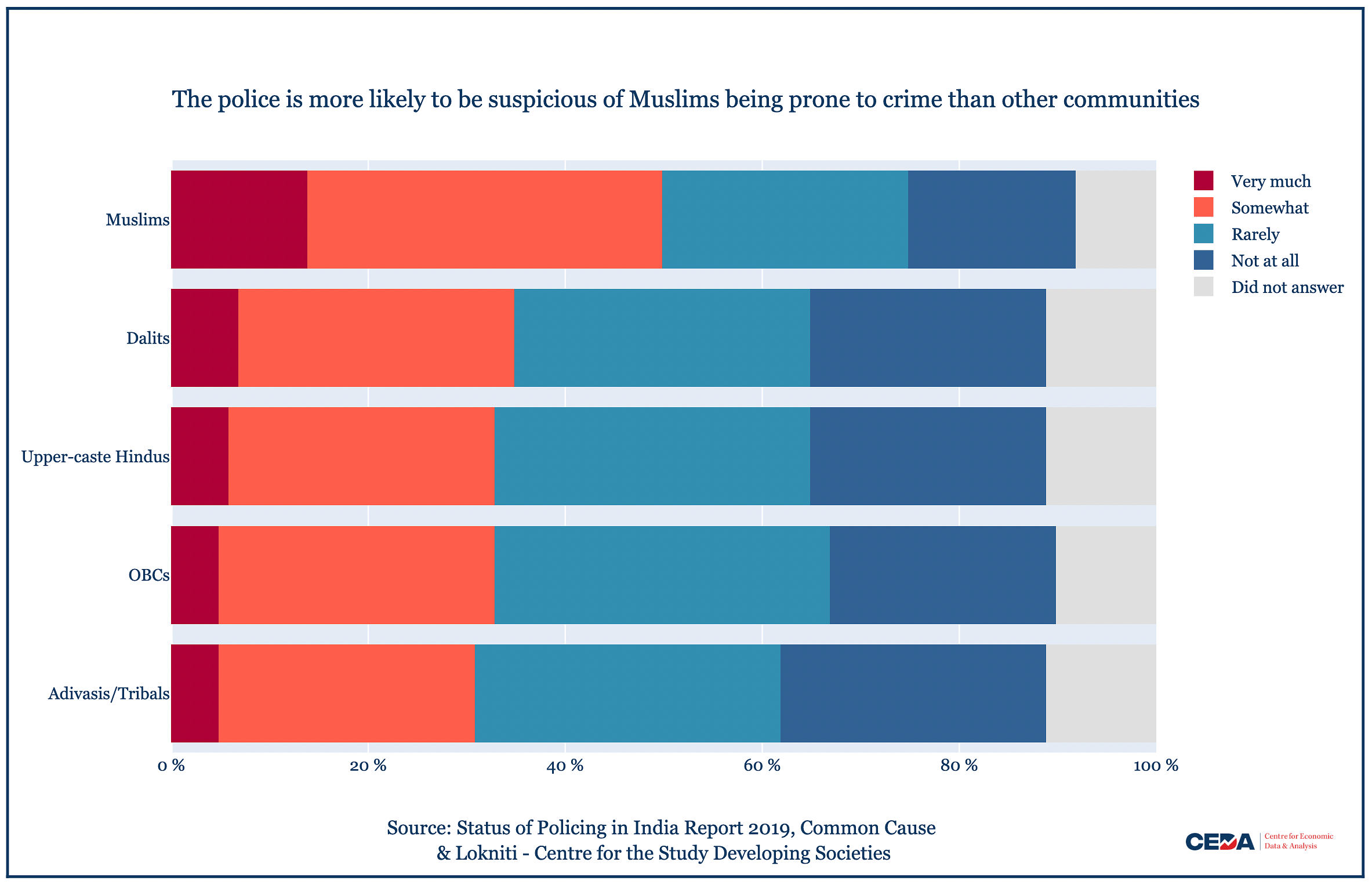
In their study of the status of policing in India (2019), Common Cause and the Centre for the Study of Developing Societies found an anti-Muslim bias among the police personnel surveyed. Respondents were asked about the extent to which people belonging to different communities were “prone towards committing crime”. Over half of those surveyed felt Muslims were somewhat or very likely to be so, a higher share than those who thought so for other communities. This bias was stronger in some states, such as Karnataka, Jharkhand and Uttar Pradesh, as compared to others. The survey, however, did not include Sikhs or Christians within the community categories.
There has, however, been a small but notable shift in the religious composition of prisoners in the last ten years. The share of all minority groups combined has seen a small fall, and that of Hindus has seen a small expansion since 2011, both among under-trials and convicts, though the shift has been slightly greater among convicts. In 2011, Hindus formed 70.5 percent of all under-trials and 71.7 percent of convicts, while Muslims 21.2 percent of under-trials and 17.8 percent of convicts.
Also read: How Tihar jailers protected Sikh inmates after Indira Gandhi’s assassination
The share of those from SC, ST communities has been consistently high, and that of OBC communities has been rising
Along with religious minorities, those from marginalised caste and tribal communities are strikingly overrepresented among India’s prison population.
At the end of 2021, those from communities considered ‘Scheduled Castes’ formed 22.8 percent of under-trials and 21.7 percent of convicts, respectively, as compared to their share of 16.6 percent in the population as per the 2011 Census. And in contrast to their share of 8.6 percent in India’s population, those from adivasi communities belonging to ‘Scheduled Tribe’ groups, comprised 10.7 percent of all under-trials and 14.1 percent of all convicts.
Adivasis in India often end up in prison while defending their collective rights on “jal, jameen and jungle” (water, land and forests), notes the Indigenous Peoples Rights International (IPRI) in its 2022 report ‘Criminalization of, Violence, and Impunity against Indigenous Peoples’.
This is not a recent phenomenon, but can be traced back to the British colonial rule which had declared over 150 Adivasi communities as criminals under the Criminal Tribes Act, 1871. The perception of the Adivasi communities has not changed significantly, notes IPRI, and continues to be seen as dangerous, and consequently more likely to be suspected of crime.
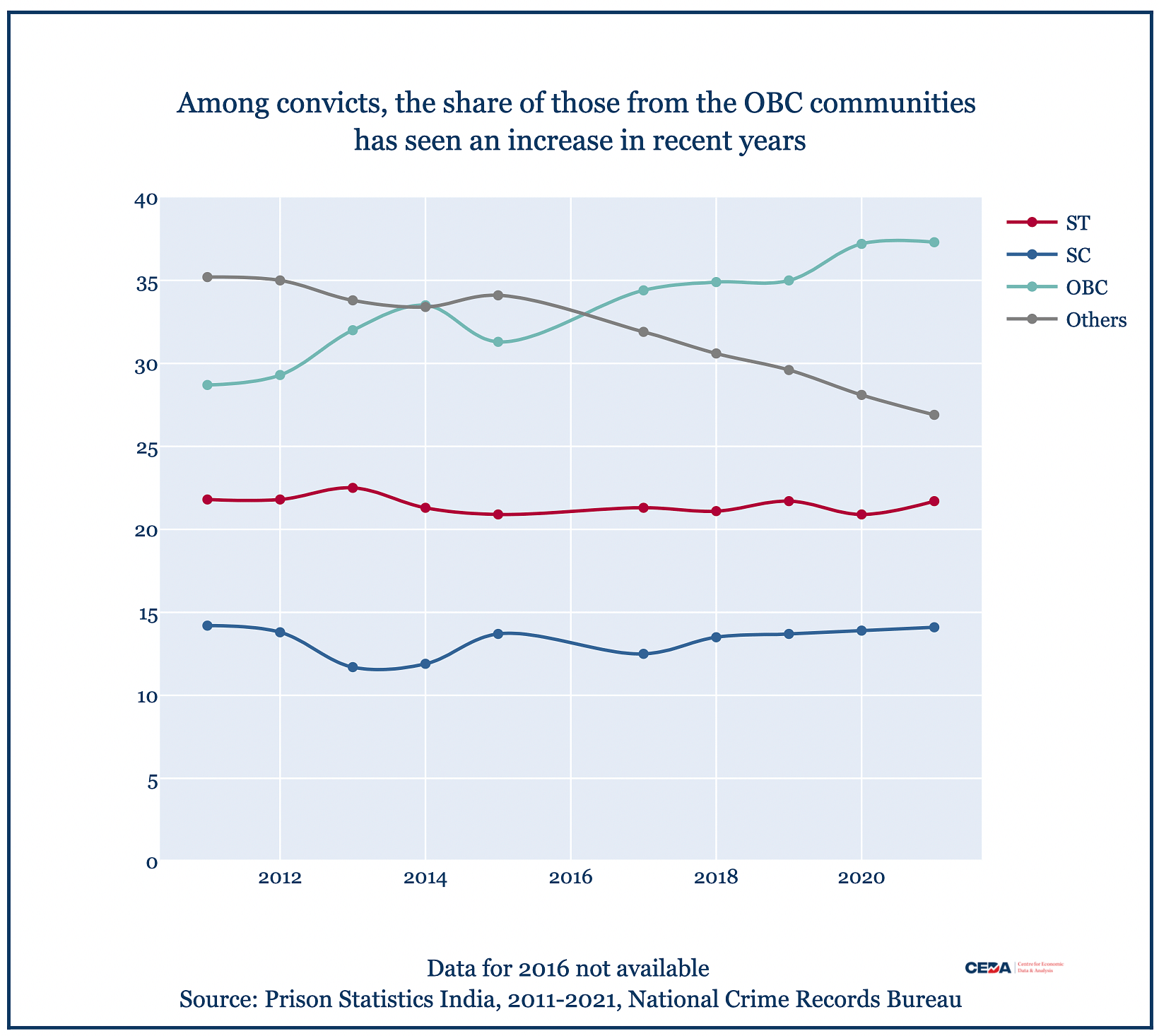
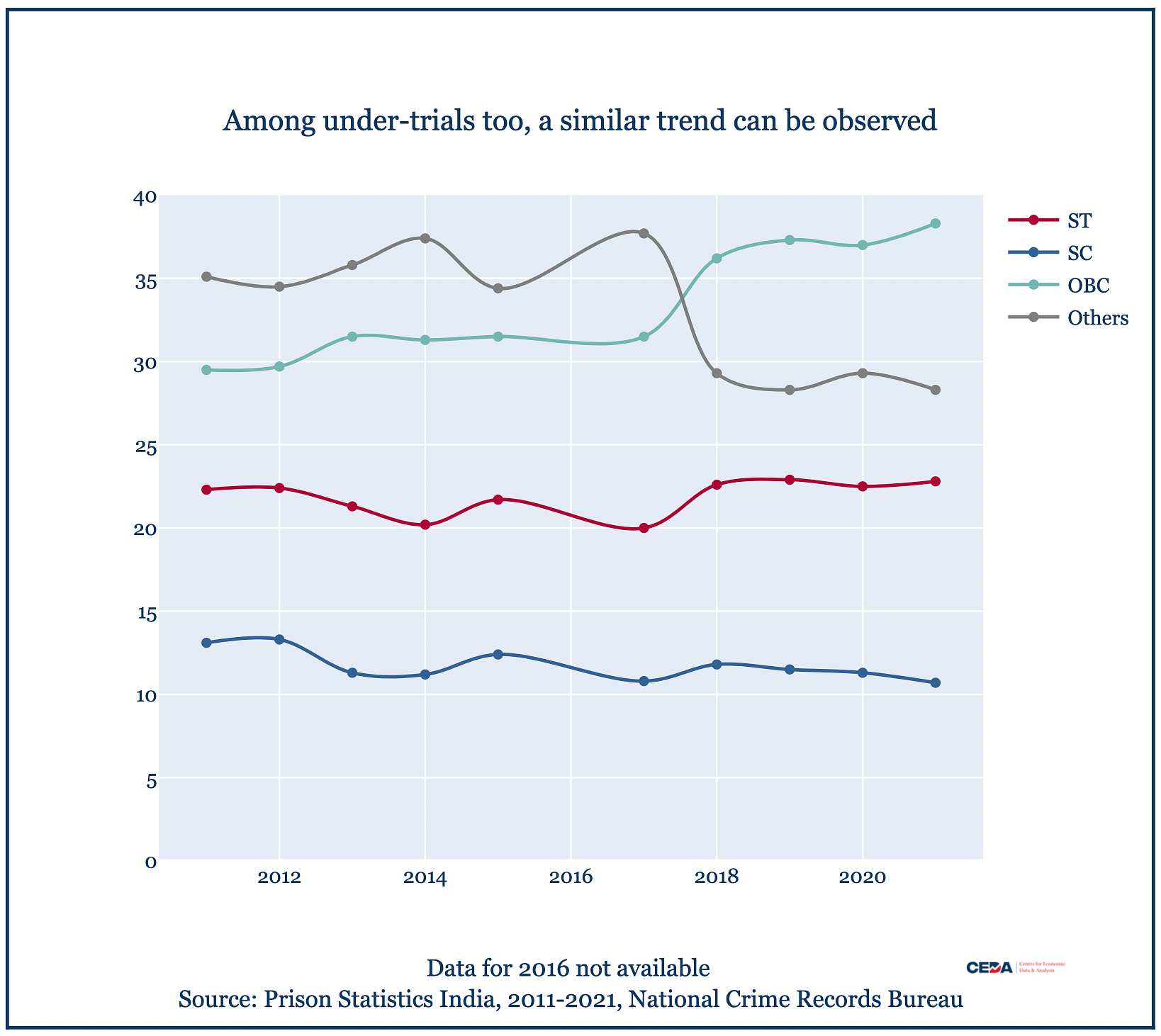
But beyond their representation among the prison population at the end of 2021, a noteworthy trend emerges in the past ten years. Prison data since 2011 shows that while the share of SCs and STs has remained largely constant among India’s prison population, the share of those from ‘Other Backward Class’ communities (OBCs) has seen a notable rise. From comprising 29.5 percent of under-trials and 28.7 percent of convicts in 2011, the community’s share grew to 38.3 and 37.3 percent of under-trials and convicts, respectively, at the end of 2021.
In the same period, the share of those from “other” groups reduced.
Several states saw a rise in the share of inmates from the OBC communities among prisoners in the past decade. In Karnataka, for example, their share among under-trials jumped from under five percent between 2011 and 2017 to 51.3 percent in 2018, and from less than ten percent before 2017 to 43.5 percent among convicts. Tamil Nadu too saw a spike in the period between 2011 and 2021.
However, the national trends seem to be driven by Uttar Pradesh which houses the largest share of prisoners from OBC communities in the country (at the end of 2021, 27.5 percent of OBC convicts and under-trials across India). In 2011, 36.2 percent of all under-trials in the state, and 36.1 of all convicts were from OBC communities. At the end of 2021, their share had risen to 46 and 46.7 percent respectively.
This shift – whether driven by changes in the classification of caste categories in these states, or by changes in the documentation methodology, or something entirely different – merits attention.
Also read: Mangalsutra, shampoo for women & sweets on festivals — UP’s new jail manual makes basics ‘official’
India’s courts have a colossal amount of cases to address, and reformed bail processes might be one way out
Currently, there are over forty one million cases in India’s lower courts and a little under six million cases in the country’s High Courts, the National Judicial Data Grid shows. Over 63 percent of the cases in the lower courts and 77 percent in the High Courts have been going on for over a year. Almost a quarter (23.6 percent) cases in the lower courts have been ongoing for more than five years, thousands of which have been ongoing for decades.
Navigating the legal system can be specifically challenging for those from marginalised communities. Lack of awareness, legal ignorance and lack of access to the right legal support and resources can mean that once imprisoned, they can end up being in jail for longer periods of time, often beyond the prescribed punishments for the crimes they have allegedly committed.
With that kind of backlog and burden facing our courts, the burgeoning shares of under-trial prisoners may remain a colossal challenge for our justice system to address for some time to come. In addition to fast-tracking the trial process, streamlined bail processes may help, a call made by none other than India’s Supreme Court recently.
Akshi Chawla is Associate Editor at Centre for Economic Data & Analysis. Views are personal. This article has been published with permission from Centre for Economic Data & Analysis.


